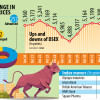A contrarian perspective in turbulent times
In the tumultuous landscape of the Dhaka Stock Exchange (DSEX), investors find themselves navigating through a maze of uncertainties. With the recent correction in the index, coupled with various macroeconomic challenges, the question arises: is the DSEX overvalued, undervalued, or fairly valued?
Let's delve into the numbers and factors at play.
From February 11 to March 28, the DSEX witnessed a significant correction of 10.37 percent, plummeting from 6,447.07 points to 5,778.33 points. Currently, the index's price-to-earnings (P/E) ratio stands at 11.64, indicating a seemingly undervalued market. However, it is crucial to dissect the historical context and broader market dynamics.
Examining historical trends, the market P/E ratios over the fiscal years show fluctuations, with the current ratio comparatively lower than previous years only except for the coronavirus pandemic period. This indicates a potential undervaluation, particularly when considering the inclusion of all listed scripts in the index calculation.
The exclusion of reputable companies such as ACI, IDLC Finance, and RAK Ceramics, coinciding with the removal of 83 firms, has raised suspicions of index calculation. Approximately 30 percent of the listed companies now lie outside the main index, distorting market perception.
Moreover, the floor prices for six companies—Beximco Ltd, BSRM Ltd, Islami Bank Bangladesh, Khulna Power, Meghna Petroleum, and Shahjibazar Power—further complicate the situation, potentially impacting market dynamics and investor confidence.
The DSEX's woes are compounded by a myriad of macroeconomic challenges. High inflation, decades of high risk-free rates, US dollar shortages, political instability, and regulatory uncertainties cast a shadow over market performance. Moreover, reduced foreign participation exacerbates the situation, contributing to a volatile investment landscape.
In the midst of challenges, contrarian investors discern opportunities amid adversity. Despite the prevailing macroeconomic headwinds, signs of underlying market value emerge.
Initiatives by the central bank to tackle non-performing loans (NPLs), enhancements in corporate governance, and significant reforms such as the adoption of a crawling peg exchange rate, removal of lending rate caps, and adherence to International Monetary Fund (IMF)-prescribed monetary and fiscal policies, provide glimpses of optimism for a potential turnaround.
The S&P 500, the index tracking the stock performance of 500 of the largest companies listed on stock exchanges in the United States, faced a 24.82 percent decline by October 2023 post-Fed rate hikes but rebounded impressively by 47 percent thereafter till now, showcasing market resilience.
In contrast, the DSEX shed 21 percent from October 2021 due to high inflation, regulatory shifts, and geopolitical uncertainties. Despite challenges, discerning investors may find opportunities amid the DSEX's correction.
Despite the challenges, optimism prevails for the DSEX. As macroeconomic factors gradually stabilise and regulatory uncertainties subside, the market is poised for a resurgence.
Investors with a long-term horizon and risk appetite stand to gain from contrarian positions in undervalued assets. With cautious optimism and strategic insights, the DSEX journey promises to be a rewarding endeavour for those willing to seize the moment.
The author is a first assistant vice-president of City Bank Capital Resources Ltd

 For all latest news, follow The Daily Star's Google News channel.
For all latest news, follow The Daily Star's Google News channel. 








Comments